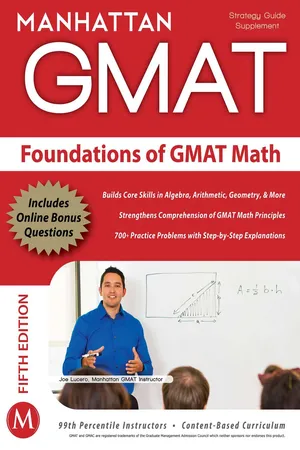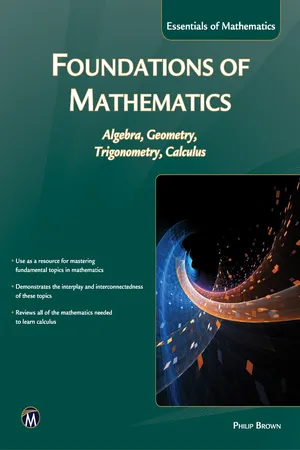Mathematics
Solving and Graphing Quadratic Equations
Solving and graphing quadratic equations involves finding the values of the variable that satisfy the equation and plotting the resulting parabolic curve on a coordinate plane. This process often includes factoring, completing the square, or using the quadratic formula to find the solutions, and then using these solutions to graph the corresponding parabola.
Written by Perlego with AI-assistance
Related key terms
Related key terms
1 of 4
Related key terms
1 of 3
3 Key excerpts on "Solving and Graphing Quadratic Equations"
- eBook - ePub
- Manhattan GMAT(Author)
- 2011(Publication Date)
- Manhattan Prep Publishing(Publisher)
Chapter 7: Quadratic EquationsIn This Chapter:• Manipulating quadratic expressions and solving quadratic equations Mechanics of Quadratic Equations In high school algebra, you learned a number of skills for dealing with quadratic equations. For the GMAT, you need to relearn those skills.Let's define terms first. A quadratic expression contains a squared variable, such as x2 , and no higher power. The word “quadratic” comes from the Latin word for “square.” Here are a few quadratic expressions:
A quadratic expression can also be disguised. You might not see the squared exponent on the variable explicitly. Here are some disguised quadratic expressions.z2 y2 + y – 6 x2 + 8x + 16 w2 – 9 z × z (y + 3)(y – 2) (x + 4)2 (w – 3)(w + 3) If you multiply these expressions out—that is, if you distribute them—then you see the exponents on the variables. Note that the second list corresponds to the first list exactly.A quadratic equation contains a quadratic expression and an equals sign.Quadratic expression = something elseA quadratic equation usually has two solutions. That is, in most cases, two different values of the variable each make the equation true. Solving a quadratic equation means finding those values.Before you can solve quadratic equations, you have to be able to distribute and factor quadratic expressions.Distribute (a + b)(x + y) Use FOILRecall that distributing means applying multiplication across a sum.
You can omit the multiplication sign next to parentheses. Also, the order of the product doesn't matter, and subtraction works the same way as addition. Here are more examples:= 5 × 3 + 5 × 4 equals five times three plus five times four. - eBook - ePub
Making Sense of Mathematics for Teaching High School
Understanding How to Use Functions
- Edward C. Nolan, Juli K. Dixon, Farhsid Safi, Erhan Selcuk Haciomeroglu(Authors)
- 2016(Publication Date)
- Solution Tree Press(Publisher)
Throughout high school, students extend their interaction with linear equations to include representing and solving systems of equations graphically. Following explorations from grade 8 when students analyzed and solved linear equations and solved systems of linear equations, high school students make sense of the solution of systems of linear equations and connect multiple representations of systems of equations to one another. In addition, they prove that the method of substitution or elimination produces a system with the same solutions.Students explore quadratic functions in the standard, factored, and vertex forms. They derive the vertex form and the quadratic formula by completing the square so that they can apply these forms to represent, understand, and solve real-world and mathematical problems. Students will further explore and apply quadratic functions and other functions in later high school work.The MathematicsThe ability to represent both real-world and mathematical situations in many different ways is important to solve problems. Students develop flexibility in the ways they mathematize situations by exploring multiple representations of functions and by justifying the procedures they use. Learning to create and use these representations is important in solving problems efficiently. High school students must be able to model contexts through visualization, explore different forms of linear functions, and explore different forms of quadratic equations.Modeling Contexts Through VisualizationStudents learn to model contexts with mathematics in elementary school and the middle grades. This often occurs in ways that are different than the ways that many teachers learned to make sense of these situations. Consider the middle school bridge task provided in figure 2.5 . How would you solve it?Figure 2.5: Bridge task.Often teachers reason in ways that mask some aspects of a mathematical relationship. For example, you might make a table to solve this problem similar to the one provided in table 2.1 . How could you use this table to find the number of beams in a bridge of length n - eBook - ePub
Foundations of Mathematics
Algebra, Geometry, Trigonometry and Calculus
- Philip Brown(Author)
- 2016(Publication Date)
- Mercury Learning and Information(Publisher)
in order to write the solution:If we allow the usual algebraic processes for taking the square roots of fractions, that is, then the solution simplifies toThese numbers involving are called complex numbers. A convenient way to write complex numbers is to use the notation Then, we can write and so the solution above can be expressed asComplex numbers and the notation i will be explained further in section 3.6 .We now derive the general formula for the solution of a quadratic equation, known as the quadratic formula. In order to solve the equation ax2 + bx + c = 0, we replace the left-hand side of the equation with the expression from formula (3.2). Thus, we need to solve the equationAs in the examples above, this means that The more usual way to write this is to use the ± notation, which means + or −, that is,The quadratic formula provides a shortcut for solving a quadratic equation. All one has to do is identify the values of a, b, and c with the coefficient of x2 , the coefficient of x and the constant term, respectively, and substitute them into the quadratic formula.REMARK 3.3.1. The quantity b2 − 4ac that appears inside the square root in formula (3.3) is called the discriminant. More about this later.EXAMPLE 3.3.5. We can solve the equation −4x2 − 13x + 7 = 0 by substituting a = −4, b = −13, and c = 7 in the quadratic formula, that is,3.4POLYNOMIALS
Polynomials and the algebraic operations that can be applied to them are the main concern of this chapter. We will begin with the formal definition of a polynomial (in one variable) and then explain how polynomials can be added, subtracted, multiplied, and divided.
Index pages curate the most relevant extracts from our library of academic textbooks. They’ve been created using an in-house natural language model (NLM), each adding context and meaning to key research topics.
Explore more topic indexes
Explore more topic indexes
1 of 6
Explore more topic indexes
1 of 4


